Ælfgif-who? provides short biographies of early medieval English women every two weeks. Click on the podcast player if you’d like to hear this newsletter read aloud in my appealing Yorkshire accent.

Eadburga: A Scribe and Poet who wrote in Gold Ink with a Silver Pen
In newsletter number 16 we looked at Abbess Leoba, who became a leading female figure in Saint Boniface’s mission to convert non-Christians in Germany. A surviving letter from Leoba to Boniface written in around 732 when she was a nun at Wimborne contains a poem, and she explains that she studied the art of writing poetry under the guidance of a woman named Eadburga.
Four letters written by Boniface and addressed to Eadburga survive, as well as one from Boniface’s successor as Archbishop of Mainz, Lull. These letters reveal Eadburga to be a trained scribe, and include many interesting details about the items that were passing between Eadburga in England, and the missionaries in Germany.
The first letter was written in around 716, when Boniface, who was from Devon, was still going by his given name Winfred. This letter is well known, as it contains Boniface’s detailed recounting of the Vision of a Monk of Wenlock. He writes to Eadburga: ‘you have asked me, my dear sister, to describe to you in writing the marvellous visions of the man who recently died and came to life again'. He explains that the visions were first recounted to him by an Abbess Hildelida, and he then spoke to the monk himself who explained his vision in his own words.
The letter then recounts that an ill monk was taken from his body and guided by angels to a place where angels and devils fought over his soul. The vision is full of frightening images of the afterlife. He saw hell, which was full of pits vomiting flames, with souls being led over a bridge over a pitch-black boiling river, with Jerusalem, shining and gleaming, at the other side. He saw the King of Mercia, Ceolred, being tortured by thousands of demons. After he was returned to his body, he woke unable to see for a whole week, and he had bleeding tumours in his eyes. The purpose of this vision was to warn him about the punishments of the afterlife if he and others did not repent their sins and live a good life. The letter tells us a great deal about the disturbing vision and not much about Eadburga, though the fact that she requested to hear about it in such detail is interesting in itself.
Two letters survive which were written in around 735, which give us more information about Eadburga. In one, Boniface thanks her for sending him holy books while he is on his mission in Germany. In another, he thanks her again for books she sent as well as garments, presumably vestments. He then adds:1
And I beg you further to add to what you have done already by making a copy written in gold of the Epistles of my master, St. Peter the Apostle, to impress honour and reverence for the Sacred Scriptures visibly upon the carnally minded to whom I preach… I am sending by the priest Eoban the materials for your writing.
In this letter, Boniface is requesting that Eadburga copy up the Epistles of St Peter in gold ink, indicating that she is a skilled scribe. Boniface requires this beautiful book to help him in his preaching in Germany, to show those he is attempting to convert. He wants his presumably illiterate audience to see that the words are physically beautiful. For him to write to Eadburga, who is far away in England, and to send a priest to travel there with the materials, indicates that her talents are highly sought after. This does invite the question of whether the ‘holy books’ she had sent to Boniface mentioned in the other letter were ones she herself had inscribed.
A fourth letter, written by Boniface between 742 and 746, asks Eadburga to pray for him while he is facing danger in his mission, as well as treachery from his own colleagues. He asks her to also pray for those who he is trying to convert, so that they will stop worshipping idols. He tells her that ‘the way of our wandering is beset by tempests of many kinds. On every hand is struggle and grief, fighting without and fear within’. This is the last letter that survives from Boniface to Eadburga. In 754, while conducting a mission to convert the Frisians, Boniface and his retinue were set upon by bandits and murdered. The bandits were disappointed to find that the luggage the retinue were carrying was not full of treasure, but manuscripts. Later sources claim that Boniface attempted to shield himself from the bandits by holding a gospel book over his head.
When Boniface went to Frisia his trusted messenger and archdeacon Lull was appointed as his successor as Archbishop of Mainz. Earlier in Lull’s career, while he was a deacon, he was also in touch with and exchanging gifts with Eadburga. A letter from 745 or 746 from Lull to Eadburga says that:2
I have sent very small gifts to your venerable love, that is a silver style, and some incense and cinnamon, that you might know from these little things how grateful I am for the gifts of your greeting.
The ‘silver style’ is a stylus, which is a pen-like tool used in writing, and would be an extremely thoughtful gift for a scribe, and one made of precious metal even more so. The other items, the incense and cinnamon, were also luxury gifts. Despite this, Lull calls her greetings to him ‘munera’ (gifts), but uses the diminutive form of the word ‘munuscula’ (small gifts) to describe what he is sending back to her. Through this he is saying that what he sends her, though luxury items, are insignificant compared to their friendship. This is the last piece of correspondence we have addressed to Eadburga, and it is unfortunate that none of her replies survive.
There are some issues with writing a biography of Eadburga using these letters. Eadburga was a common name at the time. We cannot be completely certain that the Eadburga in these letters are all the same woman.
The Eadburga in these letters is often assumed to be the same Eadburga who became the Abbess of Minster in Thanet, in Kent, who lived at the right time. I think that the Eadburga in all these letter is one woman, but that she was not Eadburga from Thanet - she was actually a nun in Wessex. Leoba’s mention of Eadburga in her letter to Boniface suggests that Boniface also knows her, which links her to his other correspondent of the same name. If this was Eadburga of Thanet, this would raise the question as to why she had moved from Wessex to Kent, especially in the political climate of the first half of the eighth century. Boniface himself was from Wessex, and living in Wessex when he wrote his first letter addressed to Eadburga. Moreover, there is good reason to think that a woman who is revealed to have worked as a scribe in the letters from Boniface and Lull also composed poetry and taught Leoba. These are related skills, and show a woman who is talented in the art of writing. Historian Barbara Yorke argues that the Eadburga in Boniface’s correspondence was likely the abbess of Wimborne, where Leoba was a nun. It is reasonable to imagine that such a learned woman would be in such a position, probably with her own scriptorium at the monastery.
There is a common yet false idea that in the early middle ages women were not educated, and that they were unable to work. While the medieval nun might be a familiar image, this role for women is often viewed as a retreat from public life, not a route into a career. In Eadburga we see an example of a woman who was skilled in writing and calligraphy, who created books and sent them across Europe. She wrote letters in Latin and Latin poetry that she taught to the other women she knew. While Eadburga had remarkable talents, it’s less useful to view her as an exception, than as an exemplification of what high-status monastic women were able to achieve in this period. Alongside other monastic women like her student Leoba, who became Boniface’s second in command, and her near-contemporary Hugeburc, who wrote an account of Saint Willibald’s pilgrimage to Jerusalem and hid her name in a secret cypher, Eadburga can be viewed as one of the intellectual elite of the early medieval period in Europe.
Suggestions for further reading:
I cannot recommend the following book enough for people who want to know more about early medieval women writers: Diane Watt, Women, Writing and Religion in England and Beyond, 650-1100, 2019
And I also really recommend: Peter Dronke, Women Writers of the Middle Ages (affiliate link), 1984
Epistolae is a wonderful and useful online collection of Latin letters written by medieval women, with translations. The letters to Eadburga are listed as ‘Eadburga/Eadburg, abbess of Minster in Thanet’, though for the reasons described above I do not agree with this attribution.
Translated by Ephraim Emerton, The Letters of Saint Boniface (New York: Columbia University Press, 1940), pp.42-3.
Translation: Epistolae: Medieval Women’s Latin Letters



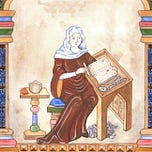



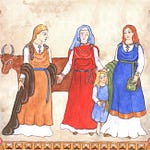
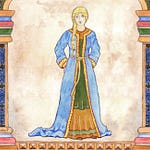
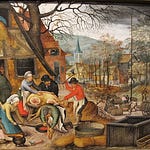
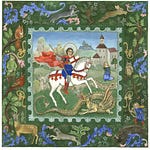



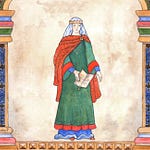
Share this post